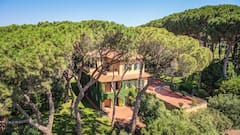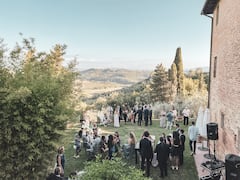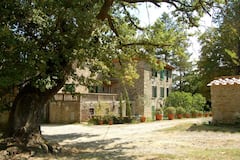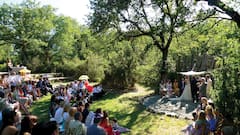To honor the gods, to hold spectacular gladiator contests, to function as the seat of government - the buildings across Italy have served a variety of purposes. The magnetic pull of Italy’s buildings isn’t, however, just about their rich legacy and how they’ve stood the test of time. Tourists come in droves, with cameras and smartphones in hand, to stand in awe of the magnificence of every cathedral, colosseum, and palace. From the elegance of Florence to the grandiosity of Rome, Italy’s architecture celebrates the classical, Gothic, Romanesque, baroque, and Byzantine styles. On every façade, in each corner, and from the bottom up, you’ll discover symmetry, flamboyance, and show-stopping qualities that are worth the long lines and crowds. For accommodation, consider booking one of the best Airbnb vacation rentals. For those traveling with loved ones, there are also plenty of rentals for families. In the meantime, continue reading to learn about the top famous buildings in Italy.
1. Pompeii Archaeological Site (from USD 55.8)

Pompeii Archaeological Site, nestled beneath the shadow of Mount Vesuvius near Naples, is an enchanting time capsule of ancient Roman life. Its fame arises from a remarkable history that was, quite literally, buried and preserved for centuries. In 79 AD, a cataclysmic eruption of Mount Vesuvius unleashed a torrent of volcanic ash and pumice, smothering the thriving city of Pompeii and its inhabitants.
This natural disaster, while devastating, inadvertently safeguarded the city, allowing modern-day archaeologists to unveil an astonishing glimpse into the daily routines, artistry, and architecture of an ancient Roman society. As you wander through its labyrinthine streets, marvel at the vivid frescoes that once adorned private homes and stand in the perfectly preserved amphitheater, where you’ll be transported back in time.
Pompeii: Entry Ticket and Guided Tour with an Archaeologist
Duration: 2.0 hour
2. Castel Sant'Angelo (from USD 14.63)

Originally constructed as a mausoleum for Roman emperor Hadrian in the 2nd century AD, Castel Sant'Angelo housed the remains of the emperor and his successors. This towering cylindrical structure, adorned with impressive sculptures, reflects a fusion of Roman and medieval architectural styles. Over time, it transformed into a fortress, a papal refuge, and a prison. Its name derives from vision that Pope Gregory the Great had in 590 AD of Archangel Michael atop the castle.
It served as a sanctuary for popes during times of turmoil, connected to the Vatican by Passetto di Borgo. Today, it stands as a museum preserving the rich tapestry of its past, housing historical artifacts, and providing panoramic vistas of Rome from its terraces.
Rome: Castel Sant’Angelo Skip-the-Line Ticket & Audio Guide
3. Colosseum (from USD 70.44)

At 188 meters (617 ft) in length, 156 meters (512 ft) in width, and 57 meters (187 ft) in height, the Colosseum is one of the most impressive buildings in Italy. The imposing structure was built between 70 and 80 AD, during the Flavian Dynasty. This is why initially it was called the Flavian Ampitheatre. It was changed to its current name when a statue of Nero, ‘The Colossus of Nero’, was erected at the entrance of the Domus Aurea, a palace built after the Fire of Rome.
The Colosseum held about 65,000 people at the time, and the massive amphitheater was used for gladiator fights, recreations of famous battles, theatrical productions, prisoner executions, and animal hunts. For more than 500 years, it remained in active use, with the final recorded games held in the 6th century. Today, the Colosseum holds the distinction as one of the Seven Wonders of the Modern World and receives six million tourists annually. So, it gets awfully crowded, which means you’ll want to get here early or get a ticket that allows you to skip the long lines.
Rome: Colosseum Fast-Track Entrance Guided Tour
Duration: 1.0 hour
You might be interested in these Airbnbs!
4. Duomo di Milano (from USD 28.19)

One of the largest Catholic churches in the world, the Duomo di Milano can accommodate 40,000 people. Construction began in 1386, guided by the vision of Bishop Antonio da Saluzzo, and was supported by the ruler of Milan Gian Galeazzo Visconti. Both wanted a spectacular building, which they certainly accomplished. The Duomo di Milano is one of the more decadent churches in the world, with 700 figures, 3,400 statues, and an abundance of gargoyles. A good time to visit would be on a Monday after vespers because that’s when one of the nails used in the crucifixion of Jesus is exhibited.
Milan: Cathedral and Duomo's Terraces Entrance Ticket
5. Sforzesco Castle

Located in Milan, the Sforzesco Castle Initially served as the fortress of the Visconti and turned into a home for the rulers of Milan: the Sforzas. It features massive courtyards, ducal rooms showcasing magnificent art, and a treasure room, among others. The family commissioned work from Leonardo da Vinci and Donato Bramante, turning the once fortress into a remarkable ducal palace. It was then used as a military complex during the four centuries of foreign occupation. Today, it houses an astonishing collection of fine art, including Michaelangelo’s last unfinished work: the Ronda Pieta.
Sforzesco Castle
Address: Piazza Castello, Milan, Italy
Website: Sforzesco Castle
Opening hours: Tue - Sun: 9am - 5:30pm (closed on Mon)
6. Giotto's Bell Tower

The bell tower was named after its architect, Giotto, although he only worked on it for three years. After the well-known architect died, Andrea Pisano and Francesco Talenti, who designed the highest point of the tower, where you’ll have a great view of Florence, took over. There are 414 steps, and no elevators. So, those who have heart problems, claustrophobia, and vertigo are advised against climbing the Giotto’s.
In the tower’s many niches, you’ll find 16 life-size statues. These have been made by different artists, which includes Donatello. But, these statues are only copies; the real things are on display at the Museo dell’Opera del Duomo.
Giotto's Bell Tower
Address: Piazza del Duomo, 50122 Firenze FI, Italy
Website: Giotto’s Bell Tower
Opening hours: Mon - Sun: 8:15am - 7:20pm
7. Pantheon (from USD 19.84)

Upon entry to the Pantheon, you may feel overwhelmed by the height of the dome and its roundness. The space is said to symbolize the vault of heaven and the dome’s shape, an intention to place all gods at an equal level of importance.
The Pantheon is one of the most preserved buildings and also one of the best places to visit in Italy. It’s also a testament to engineering and architecture. It was constructed between 118 and 125 AD as a replacement to the pantheon Marcus Agrippa, which was destroyed by fire in 80 AD. Although initially intended as a place of worship for the common, this architectural marvel also serves as a tomb for well-known figures. Renaissance painter Raphael and his fiancée are buried here, and so are Italian kings Vittorio Emanuele II and Umberto I.
Rome: Pantheon Guided Tour with Skip-the-line Ticket
Duration: 45.0 minute
8. Doge's Palace (from USD 32.1)
The Doge’s Palace is a landmark in Venice and served as the doge’s (the elected leader) official residence. It was built between the 10th and 11th centuries as a fortified central core. In the 12th century, it was turned into an elegant palace, and extensions were added in later centuries, including new prisons in the 17th century. Today, this masterpiece of Venetian Gothic is a museum with one of the most intriguing tours in the country, which includes the hidden treasures of the doge.
Venice: Doge's Palace Reserved Entry Ticket
Duration: 1 day
9. Leaning Tower of Pisa (from USD 38.0)
This famous place in Italy doesn’t need an introduction. The Leaning Tower of Pisa is not the only leaning bell tower in Italy; there is the bell tower at the church of St. Michele dei Scalzi, and another one at the church of St. Nicola. But the Leaning Tower of Pisa, with its musically-tuned seven bells, is certainly the most famous one. It forms part of a cathedral complex called the Field of Miracles, which features a baptistery, a cemetery, the bell tower, and the cathedral.
Construction of the tower began in 1173, and at that point, the structure began to lean. This was attributed to the soft ground, which began to shift, thus destabilizing the foundation. Construction was completed in the 1300s. Over the next 800 years, the Tower of Pisa began to “fall” at a rate of one to two millimeters per year.
Leaning Tower of Pisa Afternoon Admission Ticket
Duration: 30 minutes
10. Duomo di Siena (from USD 149.03)

From the busts of religious men in the past to the intricate images on the floor, Duomo di Siena impresses wherever you look. The richness in detail and the abundance of masterpieces makes this Gothic building a must-see on your Italian journey. Deemed a UNESCO World Heritage Site, it was built between 1215 and 1263. It’s a veritable feast for the eyes from inside and out. The exterior and interior feature a striking greenish black-and-white marble in alternating stripes; black and white are symbolic colors of Siena.
Look down and marvel at the mosaic pavements, which tell a story in 56 etched and inlaid marble panels. At the center is Matteo di Giovani’s “Massacre of the Innocents”. At the entrance, you’ll find some of the oldest designs in the cathedral: “Wheel of Fortune” and the “Sienese Wolf Surrounded by Symbols of Allied Cities.” Don’t leave the cathedral without checking out Donatello’s St. John the Baptist and the remarkable Piccolomini Library, which features Pinturicchio frescoes of detailed landscapes , among other images, and an impressive ceiling in blue, gold, and red.
Tip from tour guide



Take the Porta del Cielo tour of Duomo di Siena to uncover all of its beauty. I took these photos in the autumn of 2022 during a special visit to the cathedral via the tour. The cathedral is best enjoyed when the pavement is uncovered, generally in August and September. We explored the narrow passages inside and outside the building. I enjoyed the panoramic views at sunset and the walk behind the angel sculptures.
You can check the dates for the tour on the official website.
Tip from tour guide



Piccolomini Library inside Duomo di Siena features frescoes that look like parchment miniatures of large books. They are light and colorful, with gold accents and intricate details.
The library came into being when a rectangular room on the left side of the cathedral was transformed at the end of the 15th century into a library for a collection of Pope Pius II's books. The walls show 10 scenes from the life of Pope Ene Silvio Piccolomini, commissioned by his nephew, Francesco Todeschini Piccolomini. At the beginning of the 16th century, a painter from Umbria, Pinturicchio, worked on the frescoes together with his assistants, including the young Rafael Santi.
The entire ceiling is covered with so-called grotesque decorations and the floor with blue majolica, with a Piccolomini family crest depicting crescents. In the center of the hall, there is a Roman sculpture, a copy of the original Hellenistic Three Graces.
Siena: Duomo di Siena Private Guided Tour
Duration: 2.0 hour
11. Cathedral of Santa Maria del Fiore (from USD 36.0)
Built in honor of Santa Maria del Fiore, the Virgin of the Flower, this magnificent work of ecclesiastical architecture went through several architects. It was initially designed by Arnolfo di Cambio right at the end of the 13th century and finished with Emilio de Fabris in the 19th century. The dome was designed by Filippo Brunelleschi in the 15th century.
The Cathedral of Santa Maria del Fiore was constructed where the 7th-century church of Santa Reparata was nestled. Its remains are seen in the crypt. As one of the largest churches in the world, the Cathedral features impressive frescoes. There’s one depicting the Last Judgment, and the other one shows scenes from the Divine Comedy. But don’t limit yourself to the artwork; take a look at the other features, from the mosaic pavements, which appear carpet-like, to the Paolo Uccelo clock, which was designed in 1443 and still works to this day.
Tip from tour guide
 A unique thing to check out here is the Florentine clock. You probably won't be able to tell the time easily, unless you know hora italica. According to the latter, the first hour of the day is the one after sunset. This timetable was used in many places in Europe until the 18th century. The Florentine clock is still ticking; it has only one hand, which turns in an anti-clockwise direction. The clock was also beautifully frescoed by Paolo Uccello in the 15th century.
A unique thing to check out here is the Florentine clock. You probably won't be able to tell the time easily, unless you know hora italica. According to the latter, the first hour of the day is the one after sunset. This timetable was used in many places in Europe until the 18th century. The Florentine clock is still ticking; it has only one hand, which turns in an anti-clockwise direction. The clock was also beautifully frescoed by Paolo Uccello in the 15th century.
Official Cathedral Tour With Exclusive Priority Entrance
Duration: 30 minutes
12. St. Peter's Basilica (from USD 28.63)

Built according to the Renaissance and Baroque architectural styles, St. Peter’s Basilica is one of the most crucial pilgrimage sites in the world. It is located in Vatican City, the seat of Catholic faith, and built on the burial site of Peter the Apostle. Inside, you’ll find works of art from Michaelangelo, who did the initial design of the magnificent dome and sculpted ‘The Pieta’. The church can accommodate about 20,000 people. When visiting, wear the appropriate attire - no shorts for men, and no bare shoulders or short skirts for women.
Rome: St. Peter's Basilica Guided Tour
Duration: 1.0 hour
Visit Italy's finest buildings

Italy is one of the most popular tourist destinations, so even when it’s low season, prepare to line up for some key attractions. The attractions above are likely to be crowded, even in the morning. You can skip the lines by choosing tour guides that give you easier access; you could also book your tickets in advance. Another thing to think about when visiting Italy’s famous buildings is to look up restrictions, from the dress code to the closed areas.
Before you end your visit, be sure to check out some of the other fun activities in Italy, such as wine tours. Beach bums can check out the country’s gorgeous coastline at one of its beautiful beaches.
Frequently asked questions about famous buildings in Italy
History
Get Trip101 in your inbox
Unsubscribe in one click. See our Privacy Policy for more information on how we use your data
















































Create an account to